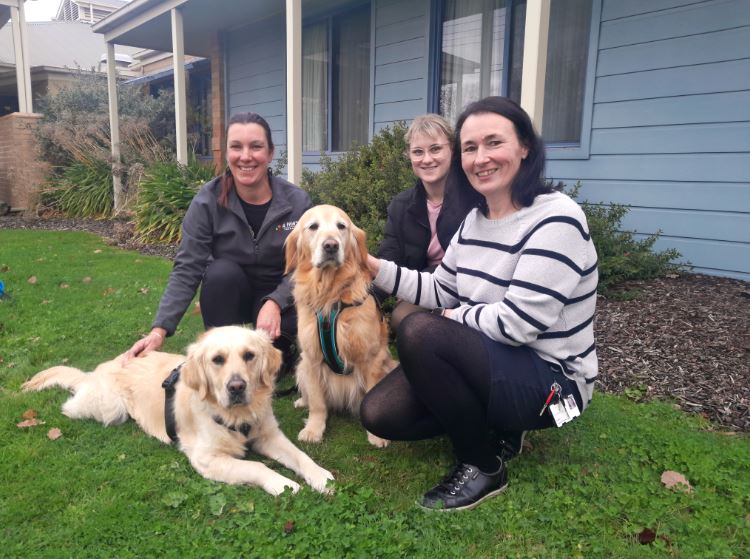Grampians Health welcomes Dog Therapy Program shaped by consumer feedback
 Pictured L to R: Jacqui MacMillan (owner of Honey and Maple) Alisha Spedding, Acting Registered Psychiatric Nurse 4, Steele Haughton Unit and Jane Wemyss, Acting NUM Steele Haughton along with Maple and Honey
Pictured L to R: Jacqui MacMillan (owner of Honey and Maple) Alisha Spedding, Acting Registered Psychiatric Nurse 4, Steele Haughton Unit and Jane Wemyss, Acting NUM Steele Haughton along with Maple and Honey
The sound of eight golden paws is helping to put a smile on the faces of residents and clients at Grampians Health Mental Health and Wellbeing units.
A dedicated visit each week from adorable 4 Paws Therapy golden retrievers, Honey and Maple, is a much-loved highlight of the week for many clients.
“It lifts the resident's and consumer's spirits when the dogs visit. It is a great distraction for them and assists them to relax” said, Alisha Spedding, Acting Registered Psychiatric Nurse 4, Steele Haughton Unit.
Chris Nielsen, Nurse Unit Manager at Grampians Health Prevention and Recovery Care (PARC) said the program started following feedback from a client who had suggested the introduction of pet therapy.
Chris recognised the potential in the idea and, following through discussions and research, introduced the pet therapy program at PARC. This initiative has since expanded to extend across Mental Health and Wellbeing units in Ballarat, such as the Parent & Infant unit, Adult Acute (AAU), Secure Extended Care (SECU), and the Aged Acute Unit and Residential Care facility at Steele Haughton, helping to enrich the therapeutic environment for clients.
Honey and Maple now visit on a mix of days at Grampians Health and the activities are “designed to facilitate emotional, mental, and physical wellbeing”, said owner Jacqui MacMillan.
“Honey, my 5-year-old golden retriever, and Maple her little sister, are Certified Visiting Therapy Dogs. With their calm and loving natures, they adore pats and cuddles, and the simple act of petting releases an automatic relaxation response, promoting the release of serotonin, prolactin, and oxytocin – all hormones that can play a part in elevating mood.”
Ben Kelly, Chief Operating Officer, said “At Grampians Health, we deeply value the feedback from our clients, patients, and consumers. Their feedback can directly shape the way we operate and help guide our actions.
"We want to understand what matters to our consumers and work with them to co-design our services. This collaborative approach not only improves what we deliver, it also can positively influence health outcomes of our communities.”

